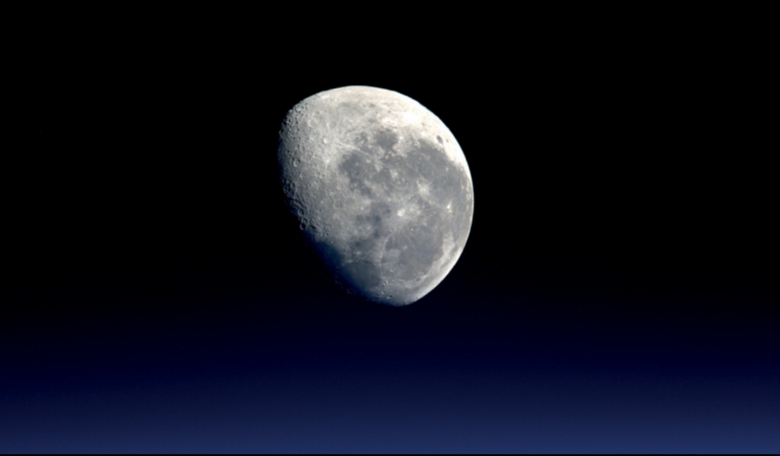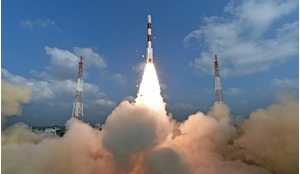When most people think of space, they think of the space race between the United States and the Soviet Union, the Apollo programme, Space Shuttle launches, the International Space Station; all high profile human exploration programmes carried out by world governments.
Many do not realise that our very way of life depends on space. Space has transformed how we communicate, navigate, produce food and energy, and conduct banking, growing our economy and connecting the world in ways that would otherwise not be possible.
We utilise space to accurately predict weather, perform disaster relief, and support national security and military functions, keeping our citizens safe. Modern luxuries that many take for granted - cell phones, television, even the Internet - are brought to us through space.
Unfortunately, these breakthroughs from space technologies are no longer assured. Potential enemies of the United States are developing capabilities to deny the use of space even if it means denying space entirely for future generations. China has reportedly demonstrated directed energy capabilities, direct ascent anti-satellite missiles, co-orbital ASATs, jamming, dazzling, and cyber attacks, one that even compelled the US to to shut down its weather satellites. China’s ASAT missile test in 2007 damaged low Earth orbit for generations to come. Likewise, the Russians have reportedly demonstrated similar capabilities. And now, a Russian Luch satellite is manoeuvring from one satellite to another in geostationary orbit.
Apart from potentially hostile activities, we face a threat from the growing population of space debris. This threat will require responsible governance and American leadership. The United States of America is the only nation that can protect space for the free world and responsible entities, and preserve space for generations to come.
The intelligence community should increasingly buy commercial data and services from private industry rather than develop, own, operate and sustain full-up space systems
These challenges can be met. We must project military strength in order to deter our adversaries, focus government space programmes where government leadership is needed and can be most effective, and promote the commercial space industry by providing regulatory certainty in addition to utilising commercial capabilities to satisfy government requirements.
Leadership and vision
My vision for space policy is one that maintains the United States as the preeminent spacefaring nation, supports our allies and improves the livelihood of people around the world.
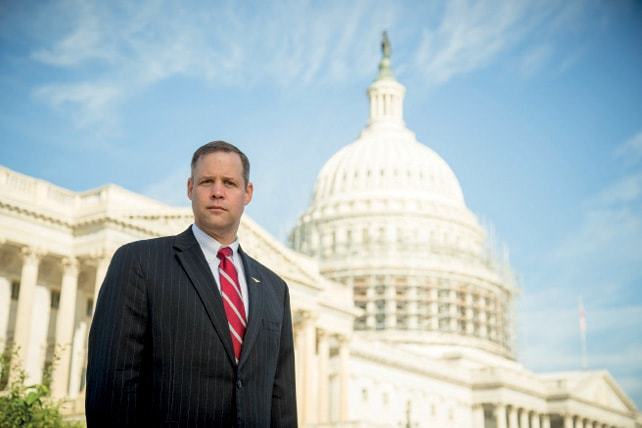 US Air Force/Lance Cheung Corey Lack Pictures
US Air Force/Lance Cheung Corey Lack Pictures
In the House of Representatives, I have the honour of serving on the Armed Services Committee, as well as the Science, Space, and Technology Committee. From this vantage point, I have the opportunity to be involved in many areas of space policy. But I have also seen how there is often a disconnect in our approach. Too often, space policy is considered in silos - national security, civil, and commercial. Policies are crafted without much thought to how they might have affects elsewhere throughout the space enterprise. Opportunities to leverage innovation are missed.
Maintaining the United States’ leadership in space will require a holistic approach to the space enterprise. This is why I introduced the American Space Renaissance Act (ASRA), comprehensive legislation examining a wide array of space policy issues.
This bill will serve as a repository for what I believe to be the best space reform ideas. It is not likely to pass in its entirety on its own, but many of the policies can be inserted into other bills that will pass.
I do not expect everyone to agree with all of the provisions of the bill. In fact, I expect many will have strong objections to some of the provisions. But these are issues that need to be discussed and solved. There are several provisions that I consider to be of high priority.
From a national security perspective, my legislation presents three lines of effort: build more resilient architectures, integrate the space enterprise, and leverage commercial solutions.
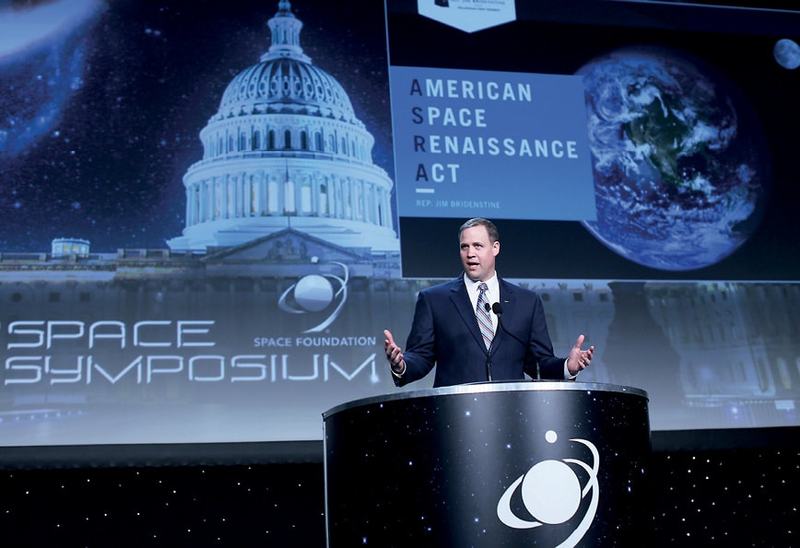 Jim Bridenstine gave a keynote address to the 32nd Space Symposium in Colorado Springs, Colorado in April 2016.
Jim Bridenstine gave a keynote address to the 32nd Space Symposium in Colorado Springs, Colorado in April 2016.
Resiliency essentially refers to the enterprise’s ability to operate effectively through attempts to degrade or destroy - directly or indirectly, intentionally or accidentally - national security space capabilities. This is not just about better protection and tactics, techniques and procedures. Rapid reconstitution capabilities should contribute to enhancing enterprise resiliency and deter conflict in the first place. An army of small launch vehicles on standby could help rapidly populate and reconstitute constellations. To support building this small launcher army, ASRA starts a Department of Defense (DoD) Venture Class Launch Services pilot programme modelled on NASA’s and awards competitive launches to support the industrial base.
Congress can push forward enterprise integration by pursuing policies which break down stove-pipes between custom-built systems. This will facilitate information sharing, situational awareness and common operating pictures. Better integrated systems have the added benefit of reducing operations and sustainment costs and manpower footprints.
For example, there is no reason why tracking, telemetry and control functions cannot be more integrated across the range of government and non-government capabilities supporting national security space operations. We must link together DoD, other government, and commercial satellite control systems. ASRA sets a deadline to fully commercialise Air Force Satellite Control Network (AFSCN) by 2018.
Decades of reform
Congress has pursued defence acquisition reform for decades. Despite enacting numerous reforms, major defence acquisition programmes - particularly space programmes - generally continue to deliver behind schedule and over budget.
The problem is compounded by the fact that private industry is increasingly outpacing traditional DoD and Intelligence Community (IC) programmes in terms of technological development and, in particular, technology insertion, refresh and rapid upgrades to fielded systems.
ASRA provides authority and funding for DoD to start a pilot programme to buy, test and evaluate commercial weather data and services
In this new environment - where commercial industry continuously leads on the technological cutting-edge - the national security space community shifts the paradigm: DoD and the IC should increasingly buy commercial data and services from private industry rather than develop, own, operate and sustain full-up space systems.
Commercial solutions will never eliminate the need for dedicated military and intelligence systems developed to meet mission-unique requirements. However, commercial solutions can increasingly augment and enhance the data and services provided by legacy national security space systems.
The IC’s experience with commercial remote sensing illustrates the potential for the government to heavily leverage commercial capabilities over time. Weather is one area increasingly explored by private industry with new space efforts in imagery, GPS Radio Occultation and hyperspectral sensing. ASRA provides authority and funding for DoD to start a pilot programme to buy, test and evaluate commercial weather data and services.
Realigning space exploration
Space exploration is an important part of the United States’ leadership in the world. When space exploration is in the national interest but the risks or costs are too high for commercial enterprise, our civil agencies, like NASA, must lead.
NASA is an exceptional agency that has inspired billions of people and transformed the human condition. In spite of its amazing accomplishments, the United States has seen NASA devolve from a presence on the Moon to maintaining a presence only in low Earth orbit, and become dependent on Russia for human access to space.
Over the past four and a half decades, NASA has been tasked with divergent responsibilities and objectives. Priorities have been added by various Congresses and Presidential administrations. NASA has become a jack-of-all-trades from automobile fuel efficiency to bioengineering for the handicapped. There are other federal agencies that can do these functions but NASA is the only agency charged with human space exploration.
The American Space Renaissance Act begins the process of bringing NASA’s space exploration activities in line with a doctrine of pioneering space. The bill amends the Space Act of 1958 (directing NASA to be the first to arrive at destinations in space) by lowering barriers to access and putting in place necessary infrastructure to facilitate utilisation and development of space by others, including commercial industry.
Mars serves as an opportune goal to apply this new doctrine. The National Research Council (NRC) reported in 2014 that NASA’s current budgets, strategies and missions will not get American astronauts to Mars.
Red planet priority
No agency can require an operator in high density orbital regimes to maintain a transponder or propulsion for manoeuvres
Mars should be the horizon goal for human space exploration and this bill instructs NASA to make the red planet its human spaceflight priority. Along the way, NASA should utilise somewhere we have already pioneered - the Moon - to achieve this objective, rather than pursuing missions of questionable benefit, such as the Asteroid Redirect Mission (ARM).
Given taxpayer investment, NASA should strive to retire risk and, when possible, commercialise programmes. NASA has already retired a lot of risk in low Earth orbit and the commercial sector is becoming more adept at facilitating operations in this arena. NASA has had great success commercialising the International Space Station (ISS) resupply missions and will soon benefit from commercial crew transportation to the ISS. This bill continues this trend by supporting these efforts, as well as pushing NASA to consider commercial options for habitats as well as its Earth science missions.
I believe it is more than feasible for NASA, like the DoD, to take advantage of these capabilities because it is an exciting time for commercial space. But none of this is guaranteed to continue if we do not manage space debris.
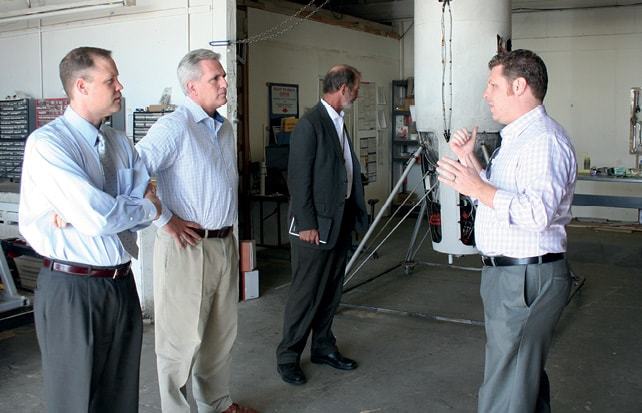 Jim Bridenstine (left) with House Majority Leader Kevin McCarthy during a visit to Masten Space Systems in Mojave, California.
Jim Bridenstine (left) with House Majority Leader Kevin McCarthy during a visit to Masten Space Systems in Mojave, California.
A 2013 study by the Inter-Agency Space Debris Coordination Committee (IADC) determined that the debris population in low Earth orbit will continue to grow due to collisions, even if nothing new is launched. Catastrophic collisions such as Iridium 33-Cosmos 2251 will occur every five to nine years. Each such collision will create thousands of pieces of debris and result in more collisions.
Instead of no new launches, however, launches will continue with increasing frequency and constellations of hundreds or even thousands of satellites will be placed in orbit. In this environment, satellites will require shielding and, correspondingly, heavier launch solutions.
Firms will need replacement satellites, more robust distributed architectures and higher cost insurance. In sum, the additional costs will reduce investment returns, challenge capital formation and limit our ability to maximise the utility of commercial space. Responsible leadership can mitigate these challenges. This starts with space situational awareness.
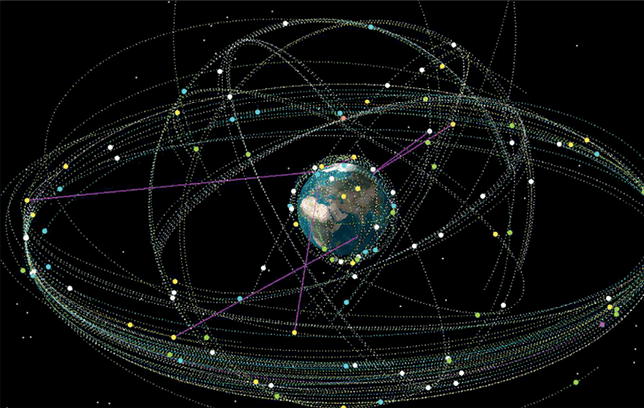 Graphic depicting satellites and their orbits demonstrates how the space around Earth is contested and congested.
Graphic depicting satellites and their orbits demonstrates how the space around Earth is contested and congested.
By default, the DoD maintains space situational awareness (SSA) and reports conjunction analyses to the various operators through the Joint Space Operations Center (JSpOC) as a by-product of its mission to protect national security assets in space.
Commercial burden
The JSpOC is also providing this service for free to foreign governments and the commercial sector. Given the unique capabilities of the JSpOC, this was the right approach in times past. However, as more nations and commercial operators have entered the market this service has become an enormous burden. It distracts from the JSpOC’s core defence mission at a time when American adversaries are jamming, spoofing and dazzling US satellites and launching very sophisticated direct ascent and co-orbital anti-satellite weapons. The JSpOC needs to use its resources to fight and win wars in space. I have heard time and time again from DoD leadership that they do not want to be the ‘FAA for Space’.
Instead, a civil agency can best fulfill this capacity. I propose that the Federal Aviation Administration’s Office of Commercial Space Transportation (FAA/AST) could be the appropriate agency.
The American Space Renaissance Act facilitates the creation of a conjunction analysis and warning centre with a single integrated space picture that fuses unclassified data from DoD, international and commercial sensors, as well as data emitted from satellites. This conjunction analysis and warning centre should be commercialised and subject to the FAA/AST’s oversight. This will require greater funding for FAA/AST, which the bill supports.
With the expansion of commercial space utilisation, the absence of appropriate regulation will result in de facto regulation of industry by increasing costs and eventually thwarting access. If we want to preserve access to space for future generations, the United States needs to also play a leadership role in space traffic management.
The United States is uniquely positioned to ensure space is secure and available for responsible actors and future generations
Right now, no agency has the authority to compel a commercial operator to manoeuvre even if there is a significant probability of collision with disastrous orbital debris results. No agency can require an operator in high density orbital regimes to maintain a transponder or propulsion for manoeuvres. In short, the US government has no authority to provide the necessary space traffic management and control in an increasingly congested environment.
Eventually, FAA/AST should be designated as the lead US government agency for space traffic management, complete with authority to take action to minimise collisions of objects on orbit. This will take time to do right. We need the greatest regulatory certainty with the lightest regulatory touch.
A responsible solution
But we cannot wait until a catastrophic collision shuts down orbital regimes for generations, which is why the American Space Renaissance Act spurs conversation about how to responsibly solve this problem and protect space not just for the industry operators who utilise it, but for us and the generations to come who benefit from the utilisation of space.
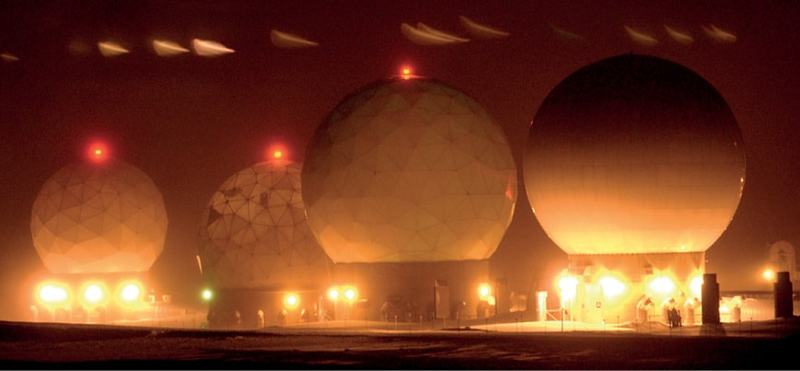 Four ‘golf ball’ radomes at Thule Air Base, Greenland. The internal satellite dishes are used to communicate with orbiting satellites.
Four ‘golf ball’ radomes at Thule Air Base, Greenland. The internal satellite dishes are used to communicate with orbiting satellites.
As I have said, I do not expect this bill to pass as a whole. But we have already been successful in taking pieces and getting them passed in other legislation. For instance, in May 2016, the House of Representatives passed the National Defense Authorization Act for Fiscal Year 2017. That bill included ten provisions from the American Space Renaissance act, including:
- New requirements for conducting the impending Satellite Communications Analysis of Alternatives to ensure the DoD fully explores commercial SATCOM capabilities and service models
- Dedicated funding to test and evaluate SATCOM pilot programmes offering DoD order-of-magnitude increases in capability and decreases in cost
- Authorisation to start a commercial weather data pilot programme. DoD would use dedicated funding to buy, test and evaluate commercial weather data and services.
Further, as of this writing, two separate appropriations bills have been referred out of the Appropriations Committee to the whole House containing provisions for directing NOAA to utilise commercial weather data sources, increasing funding for FAA/AST and eliminating funding for the Asteroid Redirect Mission. All of these are policies promoted by the American Space Renaissance Act.
As Congress continues to work through the appropriations process, and potentially consider legislation to reauthorise NASA and the FAA, it is my intention to get even more provisions inserted. We have great partners, both Republicans and Democrats, who we work with closely on different provisions. Space policy is unlike any other area of policy in that it is bipartisan. Disagreements exist, of course, but rarely along party lines.
This is why I am confident, regardless of the outcome of the fall elections and whoever the next President is, that I will be able to continue working with my congressional colleagues, as well as the next Administration, to continue implementing provisions of the American Space Renaissance Act.
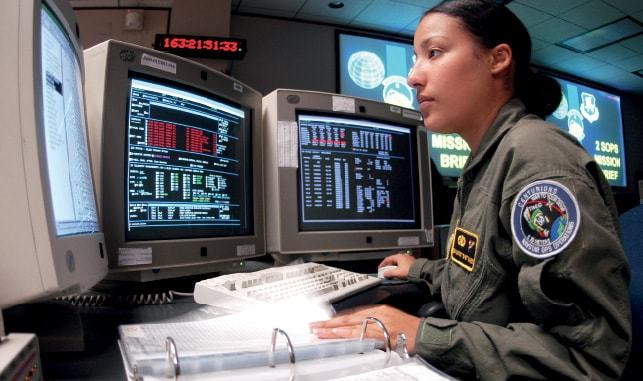 Senior Airman Nayibe Ramos runs through a checklist during Global Positioning System satellite operations at Colorado’s Schriever Air Force Base where the operations centree controls a constellation of 29 orbiting satellites that provides navigation data to military and civilian users worldwide.
Senior Airman Nayibe Ramos runs through a checklist during Global Positioning System satellite operations at Colorado’s Schriever Air Force Base where the operations centree controls a constellation of 29 orbiting satellites that provides navigation data to military and civilian users worldwide.
Space is integral to our way of life. Without it, we would not enjoy the security we have, the economic growth that has resulted, or many of the modern comforts we all take for granted. The United States has been the driving force behind many of these advances and is uniquely positioned to ensure space is secure and available for responsible actors and future generations.
If we are to keep it this way we must keep driving the conversation forward, ensuring a statutory, regulatory and legal environment that promotes smart government policies while allowing commercial industry to thrive. This is why we need the American Space Renaissance Act.
Congressman Jim Bridenstine was elected to represent Oklahoma’s First Congressional District in 2012. He is a former naval aviator, and currently a member of the Oklahoma Air National Guard. Bridenstine lives in Tulsa with his wife and their three children.





